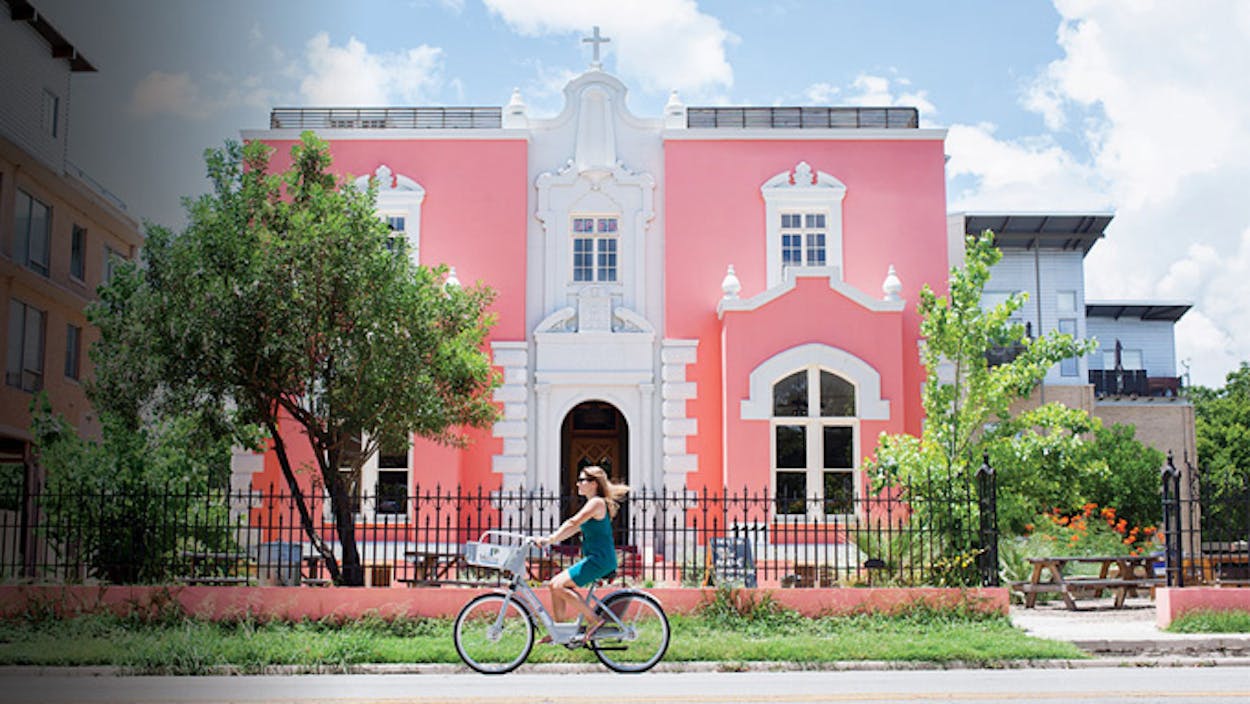Day 1
One of my favorite small towns happens to be in the second-largest city in Texas. Southtown occupies a two-square-mile swath just a few blocks below San Antonio’s touristy epicenter, but it’s much farther away in spirit. Encompassing stately neighborhoods, like the King William Historic District, and artistic hubs, like the booming Blue Star Arts Complex, it’s filled with free parking and beloved restaurants where locals outnumber visitors (try finding either of those near the Alamo). Pitching a Southtown weekend to my friends, I billed it as one part relaxing “nearcation” (“We’ll rent bikes and stay in a B&B!”) and one part anthropological excursion (“Forget the Alamo and yellow cheese. Let’s find the Beaux-Arts mansions and pork belly!”). They were dubious but game.
Normally, it takes about three minutes to drive down South Alamo Street from HemisFair Plaza, the guidebook mainstay that’s home to the 750-foot Tower of the Americas, to King William Manor, the 1892 Greek Revival manse that would be our home base. It took us considerably longer. First, we stopped to investigate Alamo Street Eat Bar—not simply a bar, as it turns out, but a food-truck park, and not, sadly, open till happy hour. Then we paused to take pictures of local photographer Sarah Brooke Lyons’s installation of “1005 Faces,” a mural of black and white portraits of San Antonians that covers the windows of the shuttered Texas Highway Patrol Museum. Four hundred feet later, we were diverted by La Vida Gallery’s array of Mexican “catrinas,” elongated female skeleton figurines dressed in their Day of the Dead best. At the Jewelry Box (734 S. Alamo, 210-270-0333), just down from a yoga studio and a Belgian bistro called La Frite, I was able to resist the estate baubles but succumbed to a red silk scarf with skulls.
Forty-five minutes later, we arrived at our room, the cozy “Amelia,” in the inn’s 1901 guesthouse, dropped our bags, and headed two blocks west to King William Street. Dense rows of pecan trees defended us from the sun, but nothing could save us from a poisonous bout of house envy as we ogled the cast-iron cresting of the three-story Steves Homestead, the Victorian belvedere of the Groos House (owned by H-E-B’s Charles Butt), and the opulent facade of Villa Finale, which offers tours six days a week. In 1967 the Italianate mansion was saved by the late preservationist Walter Mathis, who went on to restore fourteen other architectural gems in this historic German neighborhood. With protective booties on our feet, we followed a guide through two floors meticulously arranged with some 12,000 of Mathis’s prized collectibles, including a curiously sizable trove of Napoleonic memorabilia. Later, over tacos and prickly pear margaritas at Rosario’s, a Tex-Mex favorite bathed in neon-pink light, my no-longer-dubious friends and I marveled at the swirl of cultural influences we’d already experienced.
Day 2
At King William Manor, breakfast is actually served in the pink former convent down the street, a.k.a. Liberty Bar, a San Antonio fixture since 1984 that relocated to Southtown in 2010. Our omelets lived up to the menu’s “simple breakfast” disclaimer, leaving us with room to sample the red quinoa tabbouleh and comb honey at the newly launched Southtown Farmers and Ranchers Market, held in the Blue Star complex’s parking lot on Saturdays. Sipping a strawberry lemonade, I spied the fedora-wearing gentleman we’d seen pedaling by Villa Finale the previous day on a beautiful two-wheeler with a frame of wrought-iron curlicues. Southtown is dense with cyclists, but it’s not strictly BYOB. Anyone can rent a ride at Blue Star Bicycling Company (including an electric one!) or “check out” a three-speed B-Cycle, at one of the ten kiosks in the area.
Rather than go biking at noon, we opted for air-conditioned edification at the Blue Star Contemporary Art Museum, a nonprofit exhibition space founded in the mid-eighties that anchors the 160,000-square-foot Blue Star complex. The nearby San Angel Folk Art Gallery, has similarly cultivated the creative class over the years, though its cubist metal animals, whimsical diablos, and wooden owl totems are for sale. Around the corner from the Blue Star Brewing Company, and across from Stella Public House, a new “farm-to-pizza” hot spot, we came upon a metal staircase leading to a door with an “Open” sign. Curiosity lured us inside to find an industrial space chopped into artists’ studios that long predate Blue Star’s recent retail/restaurant renaissance.
Though we’d missed Blue Star’s popular First Friday gathering, our trip fortuitously coincided with Second Saturday in the neighboring South Flores Arts District. After an early dinner of miso pork belly at the Monterey, we traipsed through funky galleries and raw warehouse studios, sipping wine and chatting with artists. It wasn’t difficult to imagine ourselves as regulars of this seemingly tight-knit scene.
Day 3
When it comes to sampling the many cuisines of Southtown, three days is laughably insufficient. We’d already missed El Mirador’s sopa azteca, served only on Saturdays. And I’ve yet to taste a Pioneer Brand buttermilk biscuit at the twenties-era Guenther House. But I couldn’t pass up brunch at Feast, the sleek gray bungalow across from our B&B that locals kept suggesting (though nothing was recommended as enthusiastically as the sumptuous New American dishes at Bliss).
All weekend, I’d relied on the looming Tower of the Americas as a sort of North Star. Riding up to the top had seemed too obvious, but now I was eager to view the city from a different vantage. When the elevator doors opened onto the circular observation deck, the other sightseers rushed to find the Alamo amid the high-rises. Instead I fixed my gaze on the green expanse just to the south and tried to picture the time when Southtown was nothing but fertile farmland and San Antonio was but a small Texas town.








